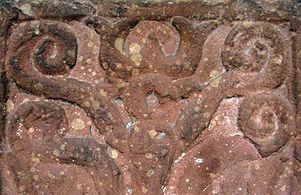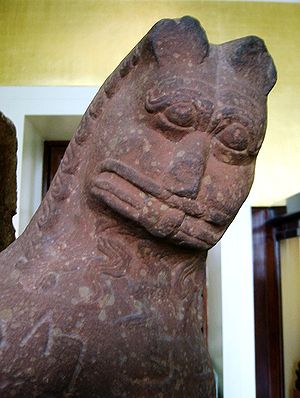
Mathura lion capital
Encyclopedia
The Mathura lion capital is an Indo-Scythian sandstone capital from Mathura in Central India, dated to the 1st century CE.
The capital is covered with Prakrit
inscriptions in the kharoshthi script of northwestern India
. The capital was made on the occasion of the funeral of "the illustrious king Muki and his horse" (Muki has been conjectured to be Maues
).
The capital describes, among other donations, the gift of a stupa
with a relic of the Buddha
, by Queen Aiyasi Kamuia, the "chief queen of the Indo-Scythian ruler of Mathura, strap Rajuvula
", mentioned as the "daughter of Kharaosta Kamuio
" (See: Mathura Lion Capital inscriptions below). The lion capital also mentions the genealogy of several Indo-Scythian satraps of Mathura. It mentions Sodasa
, son of Rajuvula, who succeeded him and also made Mathura his capital.
The capital also displays at its center a Buddhist triratana symbol, further confirming the involvement of Indo-Scythian rulers with Buddhism.
The inscription indicates support of the Sarvastivadin, against the Mahasamghikas.
It is on display at the British Museum
in the Joseph E. Hotung Gallery.
 Here is the list of the inscriptions in simplified Gandhari script:
Here is the list of the inscriptions in simplified Gandhari script:

" (an Iron Age tribe of the north-west frontier). "If we bear in mind that mb becomes m i.e mm in the dialect of Kharoshthi dhammapada, and that u is used for the common o in Sudasa in the Lion Capital Inscriptions, the Kamuia of the Lion Capital can very well represent a Sanskrit Kambojika
... I shall only add that if Kharoshtha and his father Arta were Kambojas, the same may have been the case with Moga, and we understand why the Kambojas are sometimes mentioned with the Sakas and Yavanas".
The capital is covered with Prakrit
Prakrit
Prakrit is the name for a group of Middle Indic, Indo-Aryan languages, derived from Old Indic dialects. The word itself has a flexible definition, being defined sometimes as, "original, natural, artless, normal, ordinary, usual", or "vernacular", in contrast to the literary and religious...
inscriptions in the kharoshthi script of northwestern India
India
India , officially the Republic of India , is a country in South Asia. It is the seventh-largest country by geographical area, the second-most populous country with over 1.2 billion people, and the most populous democracy in the world...
. The capital was made on the occasion of the funeral of "the illustrious king Muki and his horse" (Muki has been conjectured to be Maues
Maues
Maues was an Indo-Scythian king who invaded the Indo-Greek territories.-Conqueror of Gandhara:...
).
The capital describes, among other donations, the gift of a stupa
Stupa
A stupa is a mound-like structure containing Buddhist relics, typically the remains of Buddha, used by Buddhists as a place of worship....
with a relic of the Buddha
Gautama Buddha
Siddhārtha Gautama was a spiritual teacher from the Indian subcontinent, on whose teachings Buddhism was founded. In most Buddhist traditions, he is regarded as the Supreme Buddha Siddhārtha Gautama (Sanskrit: सिद्धार्थ गौतम; Pali: Siddhattha Gotama) was a spiritual teacher from the Indian...
, by Queen Aiyasi Kamuia, the "chief queen of the Indo-Scythian ruler of Mathura, strap Rajuvula
Rajuvula
Rajuvula was an Indo-Scythian Great Satrap who ruled in the area of Mathura in northern India in the years around 10 CE. In central India, the Indo-Scythians conquered the area of Mathura over Indian kings around 60 BCE...
", mentioned as the "daughter of Kharaosta Kamuio
Kharahostes
Kharahostes or Kharaostasa was an Indo-Scythian ruler in the northern Indian subcontinent around 10 BCE – 10 CE. He is known from his coins, often in the name of Azes II, and from an inscription on the Mathura lion capital....
" (See: Mathura Lion Capital inscriptions below). The lion capital also mentions the genealogy of several Indo-Scythian satraps of Mathura. It mentions Sodasa
Sodasa
Sodasa was an Indo-Scythian, and the son of the Great Satrap of Mathura Rajuvula. He is mentioned in the Mathura lion capital.Sodasa reigned during the 1st century CE, and also took the title of Great Satrap, probably in the area of Mathura as well, but apparently under the suzerainty of the...
, son of Rajuvula, who succeeded him and also made Mathura his capital.
The capital also displays at its center a Buddhist triratana symbol, further confirming the involvement of Indo-Scythian rulers with Buddhism.
The inscription indicates support of the Sarvastivadin, against the Mahasamghikas.
It is on display at the British Museum
British Museum
The British Museum is a museum of human history and culture in London. Its collections, which number more than seven million objects, are amongst the largest and most comprehensive in the world and originate from all continents, illustrating and documenting the story of human culture from its...
in the Joseph E. Hotung Gallery.
List of inscriptions

- A1 mahaksha[tra]vasa rajulasa
- "For the Great satrapSatrapSatrap was the name given to the governors of the provinces of the ancient Median and Achaemenid Empires and in several of their successors, such as the Sassanid Empire and the Hellenistic empires....
RajuvulaRajuvulaRajuvula was an Indo-Scythian Great Satrap who ruled in the area of Mathura in northern India in the years around 10 CE. In central India, the Indo-Scythians conquered the area of Mathura over Indian kings around 60 BCE...
"- A2 agra-maheshi ayasia
- "Chief Queen Ayasia,"
- A3 kamuia dhida
- "The kamuia daughter of"
- A4 kharaostasa yuvarana
- "The heir-apparent KharahostesKharahostesKharahostes or Kharaostasa was an Indo-Scythian ruler in the northern Indian subcontinent around 10 BCE – 10 CE. He is known from his coins, often in the name of Azes II, and from an inscription on the Mathura lion capital....
,"- A5 mada nada-diakasa [taye]
- A6 sadha matra abuhola[e]
- A7 pitramahi pishpasia bhra
- A8 tra hayuarana sadha hana dhi[tra]
- A9 a[te]urena horaka-pa
- A10 rivarena isha pradhravi-prade
- A11 she nisime sharira pradithavido
- "Has offered relics of"
- A12 bhakhavado shakamunisa budhasa
- "The bhagavat BuddhaBuddhahoodIn Buddhism, buddhahood is the state of perfect enlightenment attained by a buddha .In Buddhism, the term buddha usually refers to one who has become enlightened...
Sakyamuni"- A13 muki-[shiri]-raya sashpa [a]bhusavi[ta]
- A14 thuva ca sagharama ca cadu
- A15 dishasa saghasa sarva
- A16 stivadana parigrahe

- E1 kharaosto yuvaraya
- "The heir-apparent KharahostesKharahostesKharahostes or Kharaostasa was an Indo-Scythian ruler in the northern Indian subcontinent around 10 BCE – 10 CE. He is known from his coins, often in the name of Azes II, and from an inscription on the Mathura lion capital....
,"- E’ kamuio
- "A kamuia"
- E2 khalamasa kumara
- E3 maja kanitha
- E4 saman[u] moda
- E’’ kha karita
- B1/B2 mahakshatravasa va[ra]julasa putra
- "The son of the Great Satrap RajuvulaRajuvulaRajuvula was an Indo-Scythian Great Satrap who ruled in the area of Mathura in northern India in the years around 10 CE. In central India, the Indo-Scythians conquered the area of Mathura over Indian kings around 60 BCE...
:"- C1 kalui a
- C2 varajo
- C3 sudase kshatrave
- "The Satrap SodasaSodasaSodasa was an Indo-Scythian, and the son of the Great Satrap of Mathura Rajuvula. He is mentioned in the Mathura lion capital.Sodasa reigned during the 1st century CE, and also took the title of Great Satrap, probably in the area of Mathura as well, but apparently under the suzerainty of the...
"
- D1 nauludo
- M1 kshatrave sudise
- M2 imo padhravi
- M3 pradesho
- I1 veyaudirna kadhavaro busapa
- I2 ro kadha
- I3 varo
- I4 vi ya u
- J1 rvaraparena palichina
- J2 nisimo karita niyadido
- H'dhamadana
- H guhavihare
- KL1 ayariasa
- KL2 budhadevasa
- "The divine Buddha"
- KL3 udaena ayimi[ta]
- F1 budhilasa nakharaasa
- F2 bhikhusa sarvastivadasa
- "SarvastivadaSarvastivadaThe Sarvāstivāda were an early school of Buddhism that held to 'the existence of all dharmas in the past, present and future, the 'three times'. Vasubandhu's states:-Name:...
monk"
- G1/G2 mahakshat[r]avasa kusul[u]asa patikasa mevaki[sa] miyikasa kshat[r]avasa puyae
- "The satrap Miyika honours the great satrap Kusulaka Patika"
- J3 sarvastivadana parigrahe
- N1 ayariasa budhilasa nakharakhasa bhikhu
- N2 sa sarvastivadasa pagra
- N3 na mahasaghiana pra
- N4 ma navidave khalulasa
- O1/O2 sarvabudhana puya dhamasa puya saghasa puya
- "Revere all the Buddhas, revere the dharmaDharmaDharma means Law or Natural Law and is a concept of central importance in Indian philosophy and religion. In the context of Hinduism, it refers to one's personal obligations, calling and duties, and a Hindu's dharma is affected by the person's age, caste, class, occupation, and gender...
, revere the sanghaSanghaSangha is a word in Pali or Sanskrit that can be translated roughly as "association" or "assembly," "company" or "community" with common goal, vision or purpose...
"
- P1/P2 sarvasa sakhasta nasa puyae
- "In reverence of all the dead Sakas"
- Q1 khardaasa
- "Kharda"
- Q2 kshatravasa
- "the Satrap"
- R1 takshilasa
- "TaxilaTaxilaTaxila is a Tehsil in the Rawalpindi District of Punjab province of Pakistan. It is an important archaeological site.Taxila is situated about northwest of Islamabad Capital Territory and Rawalpindi in Panjab; just off the Grand Trunk Road...
"- R2 kroninasa
- J'1 khalasamu
- J'2 so
Interpretation
Sten Konow, who compiled a definitive listing of Indian Buddhist inscriptions, identified "Kamuia" with "KambojaKambojas
The Kambojas were a kshatriya tribe of Iron Age India, frequently mentioned in Sanskrit and Pali literature.They were an Indo-Iranian tribe situated at the boundary of the Indo-Aryans and the Iranians, and appear to have moved from the Iranian into the Indo-Aryan sphere over time.The Kambojas...
" (an Iron Age tribe of the north-west frontier). "If we bear in mind that mb becomes m i.e mm in the dialect of Kharoshthi dhammapada, and that u is used for the common o in Sudasa in the Lion Capital Inscriptions, the Kamuia of the Lion Capital can very well represent a Sanskrit Kambojika
Kamboja (name)
Kamboja or Kambuja is the name of an ancient Indo-Iranian kingdom.They are believed to have been located originally in Pamirs and Badakshan in Central Asia.The name has a long history of attestation, both in the Iranian and the Indo-Aryan spheres....
... I shall only add that if Kharoshtha and his father Arta were Kambojas, the same may have been the case with Moga, and we understand why the Kambojas are sometimes mentioned with the Sakas and Yavanas".

